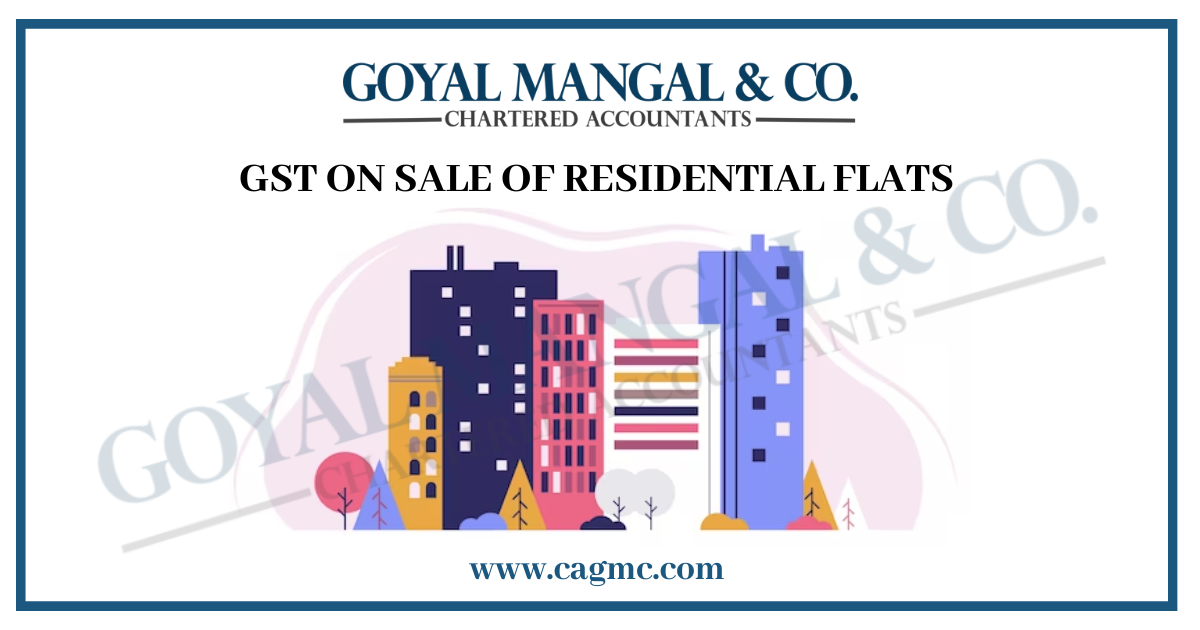
The implementation of the Goods and Services Tax in 2017 brought very significant impacts and changes to the Indian economy. The new tax regime influenced many sectors of the economy; one such sector that was significantly reformed was the real estate sector, particularly the sale of residential flats.
In this article, we will delve into the nuances of GST rates on residential property, applicable rates, exemptions, and their impact on developers and homebuyers.
Contents:
GST rates on sale of Residential Flat
The GST rates on residential property by an individual vary depending on the type of property sold. The property can be:
- Under construction
- Ready to move in
- Based on housing benefits
We will look into each category and rate.
- GST on under-construction properties: The GST rate applicable to under-construction construction properties is 5%. But the GST is calculated only on two-thirds of the amount charged, as the remaining one-third is deemed the value of land or the undivided share of land supplied to the buyer.
- GST on ready-to-move flats: A Special provision has been made in regard to ready-to-move in flats in order to avoid double taxation as GST was already paid during the construction of the flat by the developers. Therefore, no GST is charged for ready-to-move-in flats.
- GST on property on the basis of housing benefits: The government has introduced different rates based on limited housing categories, bifurcating them into affordable and non-affordable housing. The basis of differentiation includes the limit of carpet area and property value, among others. Under this scheme, residential flats falling under the affordable housing category attract a reduced GST rate of 1%, and for the non-affordable housing category, the rate would remain the same with the others at 5% without ITC benefit. But with the ITC benefit, the rates increase to 12% for the affordable category and 18% for the non-affordable housing category. This is done to make housing more accessible to the lower and middle-income income segments of the country.
Applicability of Input Tax Credit
One of the major dynamics impacted by the changing GST rules and regulations is input tax credit. It has had a different impact on both developers and homebuyers. ITC can be claimed for the GST paid on inputs such as raw materials, services, and other construction-related expenses by the developers, which can be later adjusted against the GST liability on the sale of properties. ITC rules often keep changing input in order to curb malpractice and ensure that the benefits of tax credit are passed on to end consumers.
GST on flats below 45 Lakh
The government has always intended to make residential properties affordable and available to all income-class people in both metropolitan and non-metropolitan cities. It has launched a scheme applicable as of April 1, 2019, according to which any ongoing project or any project that commences on April 1, 2019 with a carpet area of 60 square meters in metropolitan cities and 90 square meters in non-metropolitan cities with a value of rupees less than 45 lakh shall attract a rate of 1% GST.
How to avoid GST on a flat purchase?
Below are some strategies that individuals may consider to minimize or avoid GST implications on flat purchases:
- Buy a ready-to-move in flat: As mentioned above, no GST is applicable for purchasing a ready-to-move-in flat as it has already been paid by the developers during the construction of the project.
- Buy a resale property: Where the property has already been sold once and you purchase the property from that individual, you may be exempt from paying GST as it has already been paid by the first-time purchaser.
- Affordable Housing Projects: Affordable housing projects can also be considered while buying a property as they come with concessional GST rates.
Impact on Developers and Home Buyers
The inclusion of GST in the real estate sector has significantly impacted the costs and compliances to be borne by developers and homebuyers. The developers now, with the new tax regime, have to meticulously manage their tax calculations while considering the cost of raw materials, affordable housing criteria, and ITC eligibility. Therefore, efficient cash flow management and compliance with GST regulations become paramount for sustainable business operations.
buyers, The buyers, on the other hand, now need to stay updated with the GST rates at different stages of construction. Although ready-to-move-in flats don’t attract GST, they are often priced at premium rates. On the other hand, under-construction properties may be more affordable, but buyers need to navigate the complexities of GST calculations. Therefore, GST has, although it has benefited some sectors, also increased the complexities for developers and homebuyers.
Conclusion
In summary, the impact of GST on the sale of Residential Flats in India is consequential, Where has GST simplified the taxation system of the country, it on the other hand has also increased the complexities of the rules to be followed by the Developers and Homebuyers. They now need to stay updated with the ITC rules, GST rates, and compliances of the Act. So in order to stay updated with the latest amendments, our team of expert advisors is here to assist you at every step. Feel free to reach us at cagmc.com.







